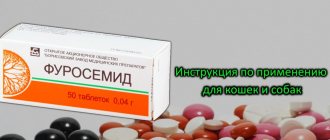Causes of heart attacks in dogs
The causes of a heart attack are acute circulatory disorders that occur as a result of prolonged spasms of the arteries. A number of heart conditions can lead to an attack. A heart attack can also be caused by a serious illness such as hepatitis.
In young dogs, an attack may be caused by a congenital defect or heavy exercise, either regular or sudden. Dog breeds such as Doberman Pinschers and Yorkshire Terriers have a hereditary predisposition to heart disease.
- During a heart attack, your dog will breathe heavily and rapidly.
- She may cough. At the same time, her mucous membranes turn pale and her tongue turns blue. Even the ears may turn pale due to the thinning of the blood vessels in the ears.
- In severe cases, signs of an epileptic seizure appear and the dog cannot stand on its feet.
- There may be attacks of suffocation when the animal cannot take a breath.
First aid for a heart attack
At the first sign of the described symptoms, especially if the animal is aging or has heart disease, first of all it needs to drop 5 drops of Cardamine or 10-15 drops of Corvalol (depending on the weight of the dog) onto its tongue.
If breathing is very difficult, you can let your dog sniff any aromatic salt or oil. In this case, it is necessary to urgently call an ambulance or carefully transport the animal to the clinic.
To prescribe optimal treatment, additional examinations are necessary:
If the attack occurs in a puppy, then such attacks may be associated with uneven growth of internal organs and a lack of calcium. The prescription of treatment depends entirely on the diagnosis of the specific heart disease. So, with endocarditis (inflammation of the inner lining of the heart), sulfonamides and antibiotics have a good effect.
Antiallergic drugs, vitamin therapy, and cardiovascular drugs are also used. Myocardosis is treated with caffeine, glucose, and camphor, ascorbic acid, and sulfocamphocaine are given. Adrenaline is used for a sharp drop in blood pressure. In the future, the dog must be protected from stress, stress and anxiety.
If breathing is very difficult, you can let your dog sniff any aromatic salt or oil. In this case, it is necessary to urgently call an ambulance or carefully transport the animal to the clinic.
Symptoms of heart failure
The manifestation and intensity of symptoms depends on the age of the animal, the cause of cardiac dysfunction and the presence of concomitant diseases.
Signs of illness in puppies
The cause of the disease in puppyhood is congenital heart defects. The disease can lead to the death of the dog if treatment is not started in time. The owner of the puppy should contact a veterinarian if there are alarming points in the pet’s behavior:
- poor appetite, drowsiness, weight loss;
- after active games, the puppy becomes lethargic, breathing frequently and heavily. Possible wheezing and shortness of breath;
- blue tongue, heavy breathing even during rest;
- fainting.
All these signs signal a weakening of the young dog’s heart muscle and require careful diagnosis.
Signs of disease in mature dogs
In mature, middle-aged animals, the disease can occur as a complication of previous infections and severe concomitant pathologies. In such cases, they speak of acquired heart failure, which in some cases develops in a latent form. To detect the disease at an early stage, it is necessary to monitor the behavior and well-being of the pet. In case of a genetic predisposition, periodic examinations are recommended.
We recommend reading: How to Make a House for a Cat in a Tree
The following signs indicate weakening of cardiac activity:
- lethargy and weakness of a usually energetic dog;
- shortness of breath even at rest;
- fainting;
- cough reminiscent of gagging;
- rapid weight gain;
- strong thirst.
These symptoms may appear as early as stage 2 or 3 of the disease. Initial changes are diagnosed only by x-ray and ECG results.
Manifestations of the disease in old dogs
Heart failure in old dogs is caused by age-related changes occurring in the body. Symptoms can be pronounced and do not go unnoticed by a loving owner:
- impaired coordination of movements;
- severe muffled cough;
- unsteadiness when walking;
- frequent noisy breathing, open mouth;
- anxiety, weakness, loss of appetite;
- When walking, the dog spreads its elbows wide. They look turned outward;
- big belly.
The veterinarian will conduct a comprehensive examination and prescribe a course of treatment to restore the animal’s health. If you consult a doctor in a timely manner, the dog will live with its owner for several more years.
Chronic heart failure develops against the background of existing diseases. Characterized by a slow increase in symptoms. The first and main sign of pathology is chronic cough. The acute condition develops over several hours. If the dog is not treated promptly, cardiogenic pulmonary edema may develop. Bloody fluid begins to ooze from the dog's mouth and nose.
Treatment for heart failure can begin only after the animal has been examined by a veterinarian. Even the most expensive medications that a caring owner will buy for his sick dog can aggravate its condition. The doctor will identify the cause of the dog’s illness and give recommendations on its maintenance and care.
Dogs of any age should reduce physical activity. Walks are reduced to 20-30 minutes, constantly monitoring your heart rate (pulse). When the diagnosis is confirmed, the animal’s diet is reviewed, limiting the consumption of salt and liquids.
Drug therapy includes taking several groups of drugs:
- cardiac glycosides (digoxin). They are appointed for life;
- potassium preparations. These medications normalize metabolism in the myocardium;
- chimes. Anticoagulant – a substance that prevents blood clotting;
- vitamins;
- diuretics to relieve edema: uregit, furosemide, spironolactone;
- for persistent edema, ethacrynic acid is prescribed;
- in case of an acute heart attack, camphor and caffeine are administered subcutaneously; into the muscle cordiamine, sulfocamphocaine.
What to do if your dog has a heart problem?
What to do if your dog has a heart problem?
Heart disease takes a leading position among all diseases not only in humans, but also in dogs. Keeping large animals in apartments, lack of necessary amounts of physical activity, poor diet, genetic predisposition to “heart problems,” poor ecology in the city - all this is only a small part of the reasons why a dog can have a heart attack.
Owners should have the necessary information about how this condition manifests itself, what needs to be done in this case, and what awaits their pet in the future.
Video “Heart failure in dogs”
A video covering the problem being considered today and talking about the symptoms and treatment of the disease awaits you further.
Sorry, there are no surveys available at this time.
Was this article helpful?
Thank you for your opinion!
The article was useful. Please share the information with your friends.
Yes (100.00%)
No
X
Please write what is wrong and leave recommendations on the article
Cancel reply
Rate the benefit of the article: Rate the author ( 3 votes, average: 5.00 out of 5)
Discuss the article:
Why does an attack occur?
Most often, the term “heart attack” refers to a disturbance in the functioning of the heart associated with pathological changes in the main heart muscle – the myocardium. Nature provides that practically no cholesterol plaques should form in the vessels of a dog’s heart, blocking the access of blood to the heart tissues. However, for the reasons given above, our pets are increasingly being diagnosed with vascular atherosclerosis, as a result of which the nutrition of the myocardium is disrupted and the dog becomes ill with the heart.
This disease is most common in older dogs, and in young animals it can occur against the background of pathologies of the endocrine system.
Signs of a heart attack
The following symptoms will help you suspect that your dog is having a heart attack::
rapid, uneven pulse;
frequent, heavy and shallow breathing;
strong excitement of the dog, fear;
head bowed down, breathing with an open mouth;
severe pain: the dog squeals, whines, tries to find a comfortable position;
the dog bends its front legs poorly, sometimes cannot use them or begins to limp on its left paw;
sudden death of a dog from a heart attack sometimes occurs in older animals.
Do not try to cope with this situation yourself, as incompetent actions can lead to the death of your pet! Immediately go to the veterinary clinic, where the dog will be provided with qualified first aid!
Symptoms, diagnosis and therapy
Immediate symptoms of a heart attack in a dog may include the following clinical signs:
- Difficult, rapid and shallow breathing.
- Head tilt. The dog can sit like this for several minutes, and in severe cases, its mouth is open.
- Arrhythmia.
- Visible signs of pain: the dog squeals, tries to take a comfortable position.
- Attacks of sudden fear, the so-called “panic attack”.
- “Rigidity” of the forelimbs, they do not bend, and occasionally the pet’s legs are completely amputated. Sometimes the dog will fall on his front left paw, which is a classic sign of heart failure.
- Sudden death of a dog from a heart attack. This happens extremely rarely, and is typical only for really old animals.
So, what to do when you see this disappointing clinical picture? Call the vet immediately, of course. We repeat once again - do not try to do something yourself! You will only make the process worse. So, sometimes you can hear that a dog having a heart attack should be wrapped in a wet, cold sheet... Official science does not know how this technique can help a sick dog, but his stress will definitely increase.
Thus, the first aid for a dog having a heart attack is to call the veterinarian. If you were on the street at that moment, and your dog became ill during a walk, do not drag him back to the apartment, but immediately try to take him to the clinic. The faster you do this, the higher the chances of a successful outcome of the case.
At the clinic, the doctor will be able to relieve a dog’s heart attack using all the necessary medications. As a rule, an animal can be helped by simply using sedatives to relieve panic, pain and fear. To determine what kind of heart pathology you are dealing with, a specialist will take an ECG. Ultrasound and X-ray examination of the chest is also indicated.
Depending on the test results, treatment will be prescribed. The veterinarian will also prescribe the medications that you will need to give your pet daily at home. Sometimes it is necessary to resort to surgical intervention, but in practice, many pathologies of the cardiovascular system in dogs can be treated well with medications.
Diagnosis and treatment
In the event of a heart attack, the doctor will first treat the condition and then examine your pet.
To begin with, the doctor will administer medications to the dog that will help him calm down, relieve pain, and restore his heart rhythm.
We recommend reading: Cat Vomits Foam and Bloody Diarrhea
After this, the dog will undergo a full examination, including:
conducting urine and blood tests;
The results obtained will clarify the picture and allow the veterinarian to make an accurate diagnosis. After making a diagnosis, the doctor will prescribe treatment for your pet, which will be based on taking a number of medications.
To achieve a stable result of therapy and prolong the life of the dog, the owner must strictly follow all the doctor’s recommendations and not stop treatment after the first signs of improvement in the animal’s health.
Preventing Heart Attacks
If your pet already has a history of a heart attack, then from now on, visits to the cardiologist should become regular, regardless of the dog’s health condition. This will help control the situation and prevent new attacks.
Particular attention should be paid to the correct distribution of the dog’s physical activity. She will not be overtired, but feasible physical activity helps to avoid obesity, which negatively affects the functioning of the heart.
If the attack occurs against the background of any underlying disease, then it is necessary to carry out constant therapy for this disease in order to avoid a recurrence of the heart attack.
The owner should review his pet’s diet and consult on this matter with the attending physician, who will develop a light and nutritious diet for the animal.
And, of course, it is very important for a dog to feel your love, see your care and live in a calm home environment!
If the attack occurs against the background of any underlying disease, then it is necessary to carry out constant therapy for this disease in order to avoid a recurrence of the heart attack.
Heart failure
This term refers to a condition when the heart is unable to fulfill its direct “responsibility”, that is, to supply organs and systems with fresh arterial blood. Naturally, it is impossible to ignore or not notice heart failure in a pet for a long time. This could end very badly.
Heart failure in dogs is a consequence of various heart diseases. It is important to understand that the occurrence of heart disease does not immediately lead to the development of heart failure. For a sufficiently long period of time, heart disease can be asymptomatic, without affecting the general condition of the animal. This is called the compensation stage.
And only when the body’s compensatory mechanisms are exhausted and various symptoms of heart failure in the animal begin to appear, the most common of which are presented below.
- Mitral valve endocardiosis. This is the most common cardiac pathology and is more common in small and medium breed dogs. Breeds such as Dachshunds and Spaniels are especially prone to endocardiosis. The causes of endocardiosis have not been fully established, but there is a clear genetic predisposition. During the course of the disease, the valves between the chambers of the heart thicken and become deformed. The severity of endocardiosis depends on the degree of valve deformation.
- Dilated cardiomyopathy. A disease common to large and giant breeds. Dobermans have a special tendency. The pathology also has a genetic predisposition. This disease is characterized by impaired myocardial contractility and, as a consequence, a progressive decrease in cardiac output.
- Congenital heart defects. They are a fairly rare pathology, accounting for about 2% of all cardiomyopathies. Unlike other heart diseases, heart defects appear at an early age.
- Dirofilariasis. A parasitic disease caused by roundworms that parasitize the right side of the heart and the pulmonary artery system. The disease is transmitted by the bites of infected mosquitoes. Symptoms depend on the degree of infestation, that is, on the number of parasites living in the heart.
Healthy and modified heart
In principle, it can be noted that heart failure in dogs is an age-related pathology. As a rule, the age of patients is over 7 years. Therefore, you need to especially monitor your elderly pet, provide assistance to it, and regularly show it to a veterinarian-cardiologist.
Heart failure is characterized by a slow, increasing development of symptoms, the main of which are:
- exercise intolerance;
- cough;
- shortness of breath, even at rest;
- pallor of the mucous membranes;
- fainting.
In severe forms of heart failure, ascites may develop - abdominal dropsy and pulmonary edema. In Dobermans, unfortunately, dilated cardiomyopathy can develop asymptomatically and end in sudden death.
Unfortunately, heart disease in animals is incurable. If a dog shows symptoms of heart failure, it requires help and lifelong treatment. It is aimed at reducing the severity of symptoms and improving the animal’s quality of life.
The main groups of drugs used to treat heart failure:
- Diuretics. They are used in the vast majority of cases, and the smallest dose that has an effect is selected. Diuretics help remove excess fluid and prevent the development of congestion in the lungs.
- Antiarrhythmics. They are also used for treatment quite often when there are disturbances in heart rhythm and pumping function of the heart.
- Angiotensin-converting enzyme inhibitors. They are used in complex treatment to reduce the pathological accumulation of fluid in the body.
- Inotropic drugs, that is, drugs that increase the contractility of the heart muscle. They are expensive, but significantly improve the quality of life of animals even at the most severe stages of heart disease.
- Omega 3-6 fatty acids. They are a food additive that, when used over a long period of time, has an antiarrhythmic effect and increases life expectancy. They are the only vitamins that actually work for the heart.
We recommend reading: Food for Neutered Cats Proplan
Why does an attack occur?
Most often, a heart attack in dogs occurs as a result of acute circulatory disorders caused by spasms of the arteries. An attack can occur as a result of a number of heart diseases. In addition, the cause of the attack may be a serious illness, such as hepatitis.
An attack in young animals can occur due to a congenital defect or physical stress that occurs regularly or spontaneously. Dobermans and Yorkies are especially susceptible to this pathology.
Important! According to medical data, in almost 50% of cases the cause of changes in the heart muscle cannot be determined.
Symptoms of myocardial infarction in dogs
It is important to be able to distinguish the signs of an attack from other diseases that do not require urgent treatment. Help for a heart attack must be provided immediately, otherwise there is a high risk of death.
- During an attack, the animal's breathing quickens and becomes heavy.
- A cough appears. All mucous membranes lose color and the tongue turns blue. Even the ears often turn pale because the blood vessels on them become thinner.
- Pain: the dog squeals for no apparent reason and tries to find a comfortable position.
- If the attack is severe, an epileptic seizure may occur, the dog loses strength and cannot stand.
- The limbs do not bend, sometimes they are taken away. The classic sign of a seizure is the animal “falling” on its left front paw.
- Head tilt. The animal can sit for several minutes with its mouth open and head tilted.
- Attacks of suffocation occur and the dog cannot breathe.
- Panic attack.
How to help a dog if it has a seizure
Care should be taken when handling older animals or those with heart disease. At the first sign of an attack, you need to drop 3 drops of Cordiamine or 10-15 Corvalol into the dog’s mouth. The number of drops depends on the weight of the animal.
If breathing is difficult, you need to bring aromatic oil or salt to the animal’s nose. At the same time, call a veterinarian or urgently take the dog to a hospital.
Important! The unexpected death of an animal occurs for various reasons; myocardial infarction is not in first place on this list. Often only a pathologist can find out the cause.
Treatment of myocardial infarction
In order to confirm the diagnosis and be able to prescribe the most effective treatment, the specialist will prescribe the following examinations:
- Ultrasound of the heart;
- various blood tests;
- ECG;
- X-ray.
When an attack occurs in a very young dog, this can be associated with a lack of calcium or uneven growth of internal organs. Treatment depends on the disease causing the attack. For example, endocarditis is successfully treated with antibiotics and sulfonamides.
Vitamins, allergy or cardiovascular medications are quite effective. For myocardosis, caffeine, sulfocamphocaine, camphor, glucose, and ascorbic acid are indicated. Adrenaline helps with a significant decrease in blood pressure. A dog who has suffered a heart attack must be protected from stress, anxiety and high physical activity.
Methods for treating endocardiosis in dogs
Methods and methods of treating mitral valve endocardiosis in a dog depend on many factors, but mainly on the degree of neglect of the pathology, as well as on the age and general condition of the patient.
Important! Degenerative disease of the atrioventricular valves cannot be completely cured, however, correctly and timely therapy can significantly prolong the pet’s life and make it almost full.
Almost always, one of the first activities carried out when a diagnosis is made is detailed training of the pet owner in the main rules that he will need to follow in the future when caring for a sick dog. Moreover, during the first and second stages of development of the pathology, it is the owner who bears the main burden and responsibility for stopping or slowing down the processes of degenerative destruction of the valves, since, as a general rule, no medications are prescribed before the first symptoms of chronic heart failure appear.
With the help of drugs
Symptomatic treatment of mitral valve endocardiosis in dogs is carried out using the following groups of drugs:
- Diuretics (mainly Furosemide, less often Hypotazid and Spironolactone) - to enhance the diuretic function of the kidneys. Removing excess fluid from the body makes the heart work easier.
- Means for lowering blood pressure. Amlodipine is usually prescribed for this purpose.
- Angiotensin-converting enzyme (ACE) inhibitors, for example, Enalapril, are used for the same purpose as Amlodipine, but act on a different principle.
- Specific drugs that improve cardiac activity and reduce cardiac stress by increasing the absorption of intracellular calcium. In veterinary practice, an example of such a drug is Pimobendan (another trade name is Vetmidin).
- Cardiac glycosides (Digoxin, etc.) - to normalize heart rate and eliminate arrhythmia.
- Vasodilators (for example, sodium nitroprusside) are drugs that dilate and relax blood vessels, lowering blood pressure.
- Bronchodilators are medications that widen the airway in the lungs.
- Antitussive drugs.
Depending on the condition of the dog, these medications can be prescribed in the form of tablets or injections, incl. intravenous.
Surgical intervention
Theoretically, surgical treatment of endocardiosis is possible and involves either complete replacement (transplantation) of the mitral valve, or its restoration, for example, by plastic surgery of the mitral fibrous ring. However, this type of operation is so complex, expensive, requiring appropriate equipment and the qualifications of a surgeon, that they are practically not used in veterinary medicine, at least as a publicly available procedure provided for in the clinic’s price list.
Did you know? In adult dogs, the heart beats the same as a human heart - 60 - 100 beats per minute. Puppies have much more - 100 - 140 blows.
How is refractory form treated?
If mitral valve endocardiosis has entered the refractory stage, treatment is carried out according to the standard principle, but the drugs are used in higher dosages or stronger versions are selected. As the animal’s condition improves, in particular, such a dangerous complication as pulmonary edema is eliminated, the amount of diuretics is reduced, but ACE inhibitors are taken in an enhanced course. In this case, a salt-free diet and restriction of the patient’s mobility are of particular importance. In addition, constant monitoring of renal function, blood pressure and serum electrolyte levels is mandatory.
If the patient’s condition cannot be stabilized, they additionally resort to such specific auxiliary procedures as:
- thoracentesis (pleural puncture) - a puncture of the chest to remove excess fluid from the lungs, reduce pressure on the lungs and, accordingly, reduce shortness of breath;
- abdominal centesis (puncture of the abdominal cavity) - a puncture of the peritoneum to remove fluid from this area.
Sometimes, before critical symptoms are relieved, the dog needs to be brought into a state of complete rest, excluding any physical activity, for which a crate has to be used.
Care during treatment
Mitral valve endocardiosis is a chronic pathology that requires lifelong treatment, and therefore in this case it would be correct to say about the correction of animal care, which should be taken as a basis and never change.
So, depending on the severity of the animal’s condition, a set of the following rules and measures is recommended:
- strict control over body weight, preventing the development of obesity;
- constant, but gentle physical activity to maintain muscle tone (the intensity of exercise or a temporary ban on it is determined by the veterinarian in each specific case individually);
- daily blood pressure measurement at home;
- constant monitoring of respiratory rate and heart rate;
- a special diet containing a limited amount of salt;
- timely detection and treatment of any additional diseases (chronic heart failure can complicate their course);
- thorough anthelmintic prophylaxis (cardiac endoparasites are especially dangerous for a sick animal);
- control chest X-ray, laboratory tests for helminths and, if necessary, other examinations - at least once a year.
Tips for dog breeders
The dog should not be fed for the first hours after an attack, but water should be given as much as the animal wants. It is important to remember that after visiting the veterinarian, your pet may experience discomfort and be scared, so its behavior will not be the same as usual. For the first 48-72 hours, you need to observe the dog’s behavior: if any alarming factors appear, visit the specialist again.
During an attack, the dog’s limbs do not bend, the mouth is open, and attacks of suffocation and panic attacks may occur.
After an attack, examinations by a specialist should become regular: at least once every three months. It is important to strictly follow the specialist’s recommendations and give all medications in a timely manner. If an animal has hypothyroidism, obesity or diabetes, it must take a certain set of special medications throughout its life. Some clinics in Europe practice implantation of pacemakers, but the cost of this treatment method is too high.
We recommend reading: Can dogs be given water and soda?
It is important to know that you can reduce the risk of an attack by eating the right foods that contain the necessary elements. To choose the right diet, you need to consult a veterinarian. Calcium and phosphorus should be present in equal amounts in the food of a sick dog, as this is extremely important for the proper functioning of the heart.
We recommend watching the video to see what a myocardial infarction looks like in a dog.
It is important to be able to distinguish the signs of an attack from other diseases that do not require urgent treatment. Help for a heart attack must be provided immediately, otherwise there is a high risk of death.
Heart attack in dogs
Emergency first aid for a dog
Often, for various reasons, dogs can have a heart attack, the cause of which can be severe nervous excitement, prolonged stress (for example, prolonged separation from the owner). The main symptoms are difficulty breathing, darkening of the mucous membranes of the gums, foam from the mouth, and a sharp increase in temperature. If this happens, the dog should be doused with cold water to reduce its body temperature and the pet should be immediately sent to a veterinary hospital.
Indirect cardiac massage
This complex procedure is recommended for use in cases where there is a circulatory disorder, respiratory arrest occurs due to heat stroke, sunstroke, electric shock, anaphylactic shock, severe carbon dioxide poisoning, exhaust gases, diabetic crisis, acute heart failure. To improve the condition of the injured animal, cardiac massage and artificial respiration are performed.
The artificial respiration procedure is based on alternate compression and expansion of the chest, which leads to the entry and absorption of air into the lungs and the expulsion of exhaust air. When carrying out this procedure, it is very important to ensure that the dog’s tongue does not sink in, otherwise the animal may suffocate. The dog is placed on its stomach, the front limbs are extended to the maximum, and the head is placed on the paws. Artificial respiration is performed while standing over the dog on your knees, placing your palms on the sides of the sternum. Leaning forward, you need to squeeze the animal’s chest with your hands, and straightening up, release the pressure on the sternum without lifting your palms. The time of each compression should not exceed two to three seconds. The frequency of presses per minute should be from 12 to 15 times.
You can do artificial respiration in a simpler way. The dog's forelimbs are pulled forward, which corresponds to the act of inhalation, after which they are pressed against the sternum (the act of exhalation). You need to maintain the same rhythm as described above, and also monitor the position of your pet’s tongue. It is worth noting that in case of any injuries to the sternum, these methods are contraindicated, as they can aggravate the consequences of the injury.
In case of chest injuries, artificial respiration is performed “mouth to nose”, which is often used when providing first aid to newborn puppies. The mouth blows air through the nostrils, holding the dog's jaws closed, which corresponds to the act of inhalation. Exhalation occurs spontaneously as soon as you remove your lips from the dog's nostrils. The rhythm should be 12-24 times per minute. The artificial respiration procedure must be carried out until the animal begins to breathe on its own. It is advisable to use the help of another person, especially if there is no breathing and the pulse cannot be felt. In this case, one person will compress and release the sternum, and the other will perform artificial respiration. The main thing is to maintain strict rhythm. In addition, to improve blood flow and provide additional blood flow, it is recommended to slightly lift the dog's pelvis and massage the groin area.
In case of anaphylactic shock, collapse, electric shock and other situations that lead to cardiac arrest, indirect cardiac massage is performed along with artificial respiration. If the dog is small, weighing up to 7-8 kg, the animal is placed on its side. In large breed dogs, all manipulations are carried out in a dorsal position, and it is desirable that the muzzle is lower than the body. It is necessary to rhythmically compress the chest in the area of the heart with a frequency of about 80 compressions per minute in large breeds and 120-125 compressions in small breed dogs. Be sure to measure your pulse and monitor your heart rate during the procedure. As soon as a weak pulse appears, you can begin artificial respiration and immediately send the injured animal to a veterinary clinic for further stabilization of the condition.
Emergency first aid for a dog
Symptoms of heart disease in a dog
Heart failure can be acute or chronic. There are more than enough warning signs for this disease:
- During walks, and not only during walks, the owner notices that his pet has breathing problems. The dog is suffering from shortness of breath. This may be the first sign of a serious illness. And don’t put off going to the doctor.
- For no apparent reason, the pet’s heart begins to beat very quickly. And this is repeated repeatedly. Tachycardia is not something to joke about. After all, this is also a rather serious signal.
- The appearance of wheezing in the lungs can also be the beginning of heart failure in an animal.
- High blood pressure is a sharp signal that requires an immediate visit to the veterinarian.
- Fainting is one of the signs that predicts heart failure.
- An enlarged liver may indicate this disease.
- The dog's chest and paws swell. This is also one of the signals that requires an immediate visit to the veterinary clinic to establish a diagnosis for your pet.
- A fairly common symptom is an increase in the size of the heart.
- Left ventricular failure often leads to pulmonary edema.
- A persistent dry cough is another sign of this disease. It may be the only sign of such heart disease.
- If acute heart failure begins, it is necessary to inject caffeine and camphor under the skin. In addition, sulfocamphocaine and cordiamine drugs are administered.
Chronic heart failure in dogs can occur as a result of previous illnesses. In such cases, heart failure is a consequence. It develops slowly, constantly, unchangeably. Reminding yourself more and more often.
Acute heart failure manifests itself differently. Firstly, it develops quite rapidly: from a few minutes to a couple of hours. In this case, the signs are clearly expressed:
- cough,
- wheezing,
- shortness of breath,
- pulse
- the mucous membrane gradually becomes pale.
In the acute form, pulmonary edema occurs quite quickly. This often results in a cough and bleeding from the mouth and nose.
The need for diagnosis of heart disease in dogs
In order to correctly establish a diagnosis, it is necessary to conduct diagnostic studies. This can only be done after consultation with a veterinary cardiologist. It is he who will offer your pet to undergo the necessary examination. For this purpose, blood and urine are tested. An electrocardiogram, an x-ray are taken, blood pressure is measured, and an ultrasound examination of the heart is performed. After which, after studying the examination results, the doctor makes a diagnosis and prescribes treatment.
The first signs of a heart attack in dogs
Heart attacks in dogs occur in any breed and at any age. The death of part of the heart muscles, or a heart attack, is a serious pathology that causes an irreparable blow to the entire blood system and the functioning of blood vessels. Poor circulation, as well as a disturbed cardiovascular system, very often provoke serious problems. Like people, our pets also often experience this pathology.
If the owner of the animal has doubts about the health of the pet, or needs necessary medical assistance, you should immediately contact a veterinary clinic for a consultation. After a heart attack, the animal requires special care, as well as constant medical supervision. Prevention of heart disease should be carried out throughout the life of the animal.
We recommend reading: Cats Their Diseases Photo Treatment
Preventive measures
Since a heart attack for an animal is a serious stress that causes irreparable harm, everything must be done to avoid such an event. The main preventive measures are annual diagnosis and testing to know the state of the cardiovascular system and possible heart problems.
To do this, you need to constantly use a special balanced food in the animal’s diet, which contains a sufficient amount of vitamins and microelements. Be sure to constantly monitor your pet's activity.
Signs occur against the background of difficult, rapid breathing, as with tachycardia. To make it easier, the dog can lower its head while in a sitting position. Poor circulation can cause chronic heart defects, which later develop into heart attacks. A heart attack can manifest itself in different ways and harm the animal to varying degrees, but the symptoms are similar in most breeds. Every owner of four-legged animals should know and be able to apply first aid for a heart attack.
Signs and symptoms of a heart attack in dogs
Signs occur against the background of difficult, rapid breathing, as with tachycardia. To make it easier, the dog can lower its head while in a sitting position. Poor circulation can cause chronic heart defects, which later develop into heart attacks. A heart attack can manifest itself in different ways and harm the animal to varying degrees, but the symptoms are similar in most breeds. Every owner of four-legged animals should know and be able to apply first aid for a heart attack.
Symptoms of a seizure in dogs are usually general in nature and appear to a greater or lesser extent regardless of the age and size of the animal. General ones can be distinguished as follows:
- breathing is rapid, sometimes difficult;
- The dog lowers its head down to relieve pressure. This is one of the main symptoms, since this position is not typical for four-legged animals, and rapid breathing indicates the criticality of the situation;
- arrhythmia;
- the dog tries to lie down comfortably and may whine periodically;
- Just like humans, dogs can experience a panic attack. Stress and overexertion can affect a dog's psyche. Panic attacks, involuntary barking, excessive activity. It needs to be eliminated as soon as possible.
Rarely, rapid death may occur. It occurs more often in very old dogs when the heart cannot cope with the load and it gradually ceases to perform its function. Limbs may also be lost. The dog tries to lean on his left paw, while feeling unpleasant, painful feelings. This symptom is more common in very old dogs, or in those that have suffered more than one heart attack. In this case, the heart is too weak.
Important! If you notice any of these symptoms, seek professional help immediately.
First aid for an attack
Any first aid actions must be carried out with full knowledge of the situation. If you do not have the skills to provide medical care, or you do not know how to help, in order to avoid possible complications, it is better to immediately take the animal to the veterinarian.
First aid consists of taking the dog to the doctor as quickly as possible. If you have a heart attack on the street, you should immediately send your dog to a veterinary center. A doctor at the clinic can localize an attack and improve blood circulation. With the help of sedatives, the dog will become calmer, panic and pain will pass. Sometimes hospital treatment with constant medical examination is required.
When a heart attack is severe, doctors often use surgery; in this case, special attention must be paid to information about the reaction to antibiotics and allergic reactions.
- If first aid was carried out on time, there is no threat to the pet’s life, but after suffering an attack, the animal requires treatment and frequent monitoring by a doctor.
- If there is an oxygen cylinder in the house, it can be used to ensure that a sufficient amount of oxygen enters the animal’s body, this will give time for a doctor to arrive.
Causes of heart attack in dogs
Before a critical situation arises, pathological changes develop in the animal’s body for quite a long time. Initially, atherosclerotic plaques consisting of bad cholesterol begin to form. They, attaching to the vascular walls, layer on top of each other, narrowing the lumen, which leads to poor circulation.
The pathology progresses, the size of the plaques increases to such a size that any, even small, impact can cause rupture of the vessel walls. In the damaged area, blood clotting occurs and a blood clot forms, clogging the lumen of the vessel. Blood cannot move normally, which causes a heart attack.
Among the main causes of heart attack in dogs, experts note the following:
- changes in hormonal levels during certain age periods;
- violation of metabolic processes;
- inflammation developing in the vessels of the circulatory system;
- helminthic infestation, in which parasites migrate into blood vessels;
- excessive physical activity;
- inactivity – dogs that move little often suffer from heart disease, especially for breeds that need regular intensive work;
- frequent stressful situations;
- infection with heartworms, the larvae of which are carried by mosquitoes - when bitten, the parasite penetrates the bloodstream and settles in the pulmonary artery; During their life, worms harm blood vessels and disrupt blood flow.
Regardless of what triggered the development of a heart attack, the disease has a number of symptoms.
Treatment of an attack
After providing first aid, the doctor must conduct additional tests, with the help of which further treatment will be prescribed. Mandatory tests:
- blood tests. The first thing the doctor should do. This is the only way to know the condition of the animal;
- performing ultrasound of the heart and atrium. Ultrasound is not always effective in cases where the animal has thick and long hair;
- X-ray. Needed to see possible rib damage during a heart attack;
- ECG. Such an examination is very rarely carried out, but it best shows the condition of the blood vessels and areas that are susceptible to disease.
Sometimes heart attacks occur in puppies, in which case doctors talk about the rapid growth of internal organs and insufficient calcium. This is often evidence of genetic pathologies. In such cases, treatment is carried out with antibiotics to restore the lining of the heart.
In addition, treatment is carried out in a complex. If the doctor has prescribed antibiotics, you need to take immunostimulants with them, drugs to improve microflora and proper intestinal function. Usually, additional medications after taking antibiotics are prescribed for a long period of time to remove toxins and restore the body after stress.
During treatment and the next month after the attack, the dog requires constant rest and a minimum of active games. Nutrition and additional medications should be prescribed by a doctor. After the first case of a heart attack, do an ultrasound of the heart every six months, because there is a possibility of a second attack.











